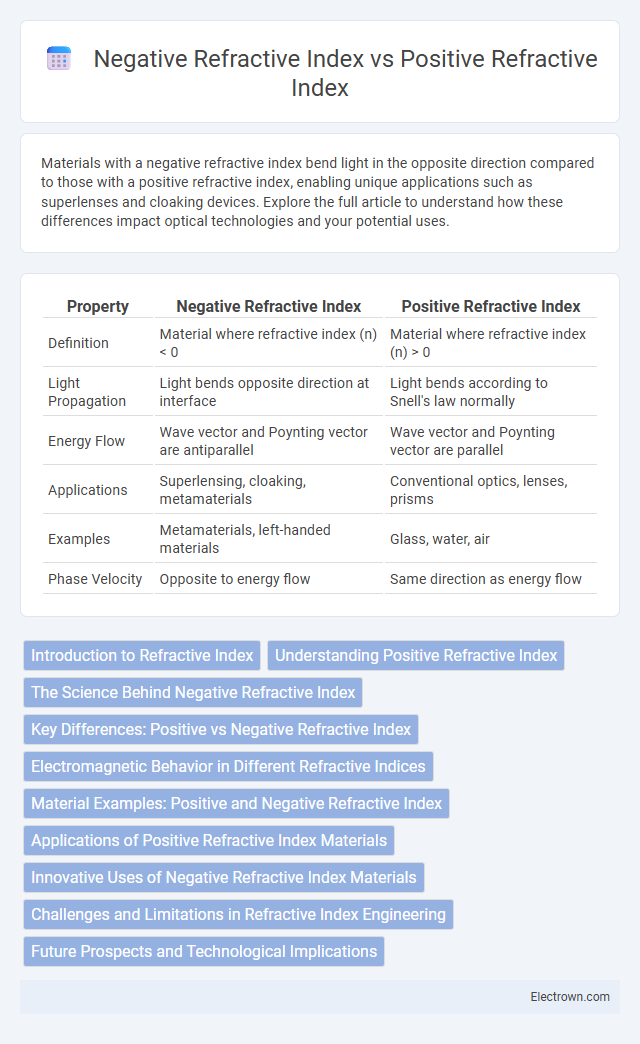Materials with a negative refractive index bend light in the opposite direction compared to those with a positive refractive index, enabling unique applications such as superlenses and cloaking devices. Explore the full article to understand how these differences impact optical technologies and your potential uses.
Table of Comparison
| Property | Negative Refractive Index | Positive Refractive Index |
|---|---|---|
| Definition | Material where refractive index (n) < 0 | Material where refractive index (n) > 0 |
| Light Propagation | Light bends opposite direction at interface | Light bends according to Snell's law normally |
| Energy Flow | Wave vector and Poynting vector are antiparallel | Wave vector and Poynting vector are parallel |
| Applications | Superlensing, cloaking, metamaterials | Conventional optics, lenses, prisms |
| Examples | Metamaterials, left-handed materials | Glass, water, air |
| Phase Velocity | Opposite to energy flow | Same direction as energy flow |
Introduction to Refractive Index
Refractive index quantifies how light propagates through a medium by indicating the phase velocity reduction relative to vacuum. Positive refractive index materials bend light according to Snell's law, causing standard refraction with phase and energy moving in the same direction. Negative refractive index materials exhibit reverse refraction, where phase velocity and energy flow oppose, enabling unique phenomena like backward wave propagation and superlensing effects.
Understanding Positive Refractive Index
Positive refractive index materials bend light in a conventional manner where the refracted wave propagates on the opposite side of the normal compared to the incident wave. This characteristic enables predictable light manipulation essential for lenses, fiber optics, and everyday optical devices. Understanding positive refractive index helps you grasp fundamental optical phenomena such as refraction, reflection, and Snell's law, which are pivotal in designing effective photonic systems.
The Science Behind Negative Refractive Index
Negative refractive index materials reverse the direction of light refraction, bending electromagnetic waves opposite to conventional positive refractive index substances. This phenomenon results from engineered metamaterials with specific structure-induced resonance, enabling unusual interactions like backward wave propagation and reversed Snell's law. Understanding this science allows you to explore applications in superlenses and cloaking devices, fundamentally altering control over light behavior.
Key Differences: Positive vs Negative Refractive Index
Positive refractive index materials bend light toward the normal, resulting in conventional refraction behavior, while negative refractive index materials bend light opposite to the normal, creating reverse refraction. This unique property of negative refractive index enables novel applications such as superlenses and cloaking devices, which surpass the limits of traditional optical components. Understanding these key differences allows you to explore advanced photonic technologies and metamaterials for innovative light manipulation.
Electromagnetic Behavior in Different Refractive Indices
Materials with a negative refractive index exhibit reverse electromagnetic wave propagation, causing the phase velocity to move opposite to the energy flow, contrasting with positive refractive index materials where phase velocity and energy propagate in the same direction. This unique behavior results in phenomena such as negative refraction, reversed Doppler effect, and inverted Snell's law, significantly impacting wavefront shaping and lens design. Electromagnetic fields in negative index materials can produce backward wave modes and enable novel applications in superlenses and cloaking devices, which are unattainable with conventional positive refraction materials.
Material Examples: Positive and Negative Refractive Index
Materials with a positive refractive index include conventional substances like glass, water, and air, where light bends toward the normal when entering a denser medium. Negative refractive index materials, often called metamaterials, include engineered structures like split-ring resonators and photonic crystals that reverse the phase velocity of light, causing it to refract on the same side of the normal. These artificial composites enable unique phenomena such as reverse Snell's law and superlensing, which are not observed in natural positive refractive index materials.
Applications of Positive Refractive Index Materials
Positive refractive index materials play a crucial role in conventional optics, enabling applications such as lenses, prisms, and optical fibers that guide and manipulate light effectively. These materials support technologies in imaging systems, telecommunications, and laser devices, where predictable light bending and focusing are essential. Your ability to design clear, efficient optical components relies heavily on the well-understood behavior of positive refractive index materials.
Innovative Uses of Negative Refractive Index Materials
Negative refractive index materials enable groundbreaking applications such as superlenses that surpass the diffraction limit, allowing imaging at resolutions finer than conventional positive refractive index lenses. These metamaterials facilitate novel cloaking devices by bending electromagnetic waves around objects, rendering them nearly invisible at specific frequencies. Their unique properties also enhance antenna efficiency and miniaturization in telecommunications, revolutionizing device performance beyond the capabilities of traditional positive refractive index substances.
Challenges and Limitations in Refractive Index Engineering
Negative refractive index materials pose significant challenges in refractive index engineering due to their inherent fabrication complexity and high losses at optical frequencies. Unlike positive refractive index materials, which are naturally abundant and easier to manipulate, achieving stable and efficient negative refractive indices requires precise nanostructuring and advanced metamaterial designs. Your ability to implement these materials in practical applications is limited by issues such as bandwidth restrictions, material dispersion, and difficulty in integrating with conventional optical components.
Future Prospects and Technological Implications
Negative refractive index materials enable unprecedented control over electromagnetic waves, potentially revolutionizing imaging technologies through superlenses that surpass diffraction limits. Positive refractive index materials remain essential for conventional optics, but integrating negative index metamaterials promises breakthroughs in cloaking devices and advanced communication systems. The future of photonics hinges on synthesizing these materials to develop ultra-compact, efficient optical circuits and next-generation sensors with enhanced sensitivity and resolution.
negative refractive index vs positive refractive index Infographic

 electrown.com
electrown.com